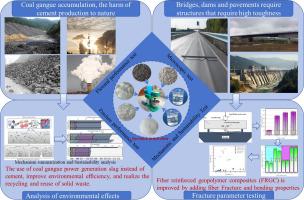废尾矿煤矸石发电渣纤维增强碱活性复合材料的弯曲断裂性能
IF 5.6
2区 工程技术
Q1 ENGINEERING, MECHANICAL
引用次数: 0
摘要
与传统胶凝体系相比,工业废渣碱活性复合材料的碳足迹更低,对各种尾矿等固体副产物的再利用潜力更高,但其脆性和弯曲断裂仍是需要进一步定制的挑战。将颗粒状高炉渣(GGBFS)和煤矸石发电渣(CPS)与玻璃纤维(GF)和聚丙烯纤维(PPF)分别以0.3%、0.5%和0.7%的掺量混合,制备低碳纤维增强地聚合物复合材料。研究了玻璃纤维和聚丙烯纤维对纤维增强地聚合物复合材料力学性能、弯曲和断裂性能的影响。通过单轴压缩、三点弯曲试验和数字图像相关(DIC)检测抗压强度、断裂行为和裂纹演化。通过双k模型定量评价裂缝特征。结果表明,玻璃纤维和聚丙烯纤维显著提高了纤维增强地聚合物复合材料的抗断裂性能。DIC分析表明,聚丙烯纤维/玻璃纤维通过桥接效应延缓了裂纹的起裂,促进了复杂裂纹网络的形成。GF-0.5组与对照组相比,裂纹起裂延迟40%,最大剪切应变降低25%,抗压强度和抗折强度分别提高19%和79%。混杂纤维组(MF-0.5)的断裂能吸收显著,为279.87 N/m,比对照组提高了689%,清楚地显示了纤维杂交的协同增强机制。SEM和FT-IR结果证实,虽然纤维可以粘附更多的C-(A)- s - h凝胶,但它加强了凝胶与纤维之间的结合,证实了混合纤维的桥接、断裂和拉出机制,大大提高了延展性、韧性和抗裂性。更重要的是,与传统的水泥基材料相比,纤维增强地聚合物复合材料可以减少35%的碳排放,降低成本。总体而言,本研究表明,利用工业废物优化地聚合物配方显著提高了性能,支持固体废物增值,并为绿色建筑材料提供了可持续发展的途径。本文章由计算机程序翻译,如有差异,请以英文原文为准。

Flexural and fracture properties of fiber-reinforced alkali activated composites derived by waste tailings coal gangue power generation slag
Industrial waste-derived alkali activated composites demonstrated lower carbon footprint, and higher reutilization potential of solid by-products, such as various tailings, compared with conventional cementitious system, but its brittleness and bending fracture remain still the challenges required to be tailored further. Herein, granulated blast furnace slag (GGBFS) and coal gangue power generation slag (CPS) were mixed with glass fiber (GF) and polypropylene fiber (PPF) at dosages of 0.3 %, 0.5 %, and 0.7 % to develop low-carbon fiber-reinforced geopolymer composites. The effects of glass and polypropylene fibers on the mechanical properties, flexural and fracture properties of fiber-reinforced geopolymer composites were studied. Compressive strength, fracture behavior, and crack evolution were examined via uniaxial compression, three-point bending test, and digital image correlation (DIC). The fracture characteristics were quantitatively evaluated via the double-K model. Results showed that glass and polypropylene fibers significantly improved fracture resistance of fiber-reinforced geopolymer composites. DIC analysis revealed that polypropylene fiber/glass fiber delayed crack initiation and promoted complex crack networks via bridging effects. The GF-0.5 group showed a 40 % delay in crack initiation and a 25 % reduction in maximum shear strain, and its compressive and flexural strengths increased by 19 % and 79 %, respectively, compared to control group. The hybrid fiber group (MF-0.5) showed remarkable fracture energy absorption of 279.87 N/m, representing a 689 % enhancement compared to control group, clearly showing the synergistic reinforcement mechanism of fiber hybridization. SEM and FT-IR results confirmed that while fiber can adhere more C-(A)-S-H gels, it strengthened the bond between gel and fibers, confirming the hybrid fiber mechanisms—bridging, fracture, and pull-out—substantially improved ductility, toughness, and crack resistance. More importantly, fiber-reinforced geopolymer composites offer a 35 % reduction in carbon emissions and lower costs compared to traditional cement-based materials. Overall, this study shows that optimizing geopolymer formulations with industrial waste significantly improves performance, supports solid waste valorization, and offers a sustainable pathway for green building materials.
求助全文
通过发布文献求助,成功后即可免费获取论文全文。
去求助
来源期刊

Theoretical and Applied Fracture Mechanics
工程技术-工程:机械
CiteScore
8.40
自引率
18.90%
发文量
435
审稿时长
37 days
期刊介绍:
Theoretical and Applied Fracture Mechanics'' aims & scopes have been re-designed to cover both the theoretical, applied, and numerical aspects associated with those cracking related phenomena taking place, at a micro-, meso-, and macroscopic level, in materials/components/structures of any kind.
The journal aims to cover the cracking/mechanical behaviour of materials/components/structures in those situations involving both time-independent and time-dependent system of external forces/moments (such as, for instance, quasi-static, impulsive, impact, blasting, creep, contact, and fatigue loading). Since, under the above circumstances, the mechanical behaviour of cracked materials/components/structures is also affected by the environmental conditions, the journal would consider also those theoretical/experimental research works investigating the effect of external variables such as, for instance, the effect of corrosive environments as well as of high/low-temperature.
 求助内容:
求助内容: 应助结果提醒方式:
应助结果提醒方式:


